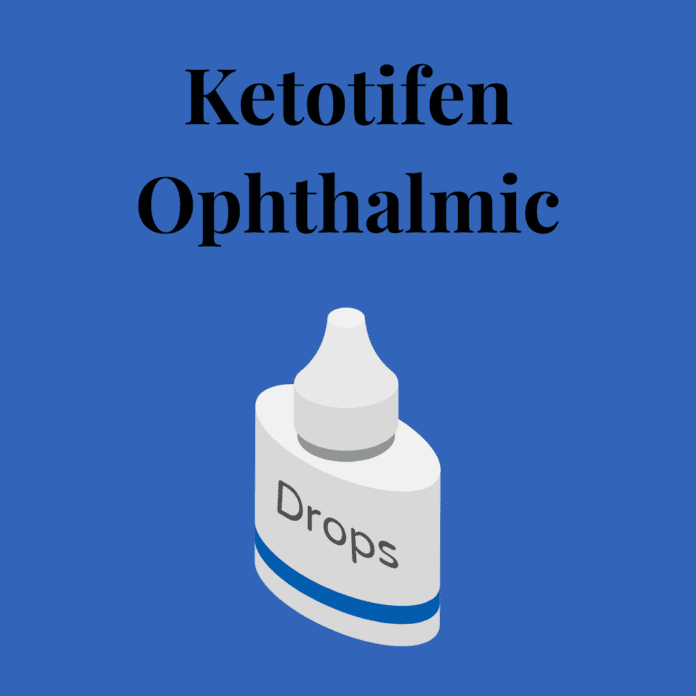Uses Of Ketotifen Ophthalmic
Ophthalmic ketotifen is used to relieve the itching of allergic pinkeye. Ketotifen is in a class of medications called antihistamines. It works by blocking histamine, a substance in the body that causes allergic symptoms.
Side Effects Of Ketotifen Ophthalmic
Ketotifen ophthalmic may cause side effects. Tell your doctor if any of these symptoms are severe or do not go away:
- headache
- runny nose
- burning or stinging of the eye
- eye discharge
- dry eyes
- eye pain
- eyelid problems
- itching
- problem with tear production
- blurred vision
- sensitivity to light
- rash
- flu-like symptoms
- sore throat
Ketotifen ophthalmic may cause other side effects. Call your doctor if you have any unusual problems while using this medication.
Warnings & Precautions
Before using ketotifen ophthalmic:
- tell your doctor and pharmacist if you are allergic to ketotifen or any other medications.
- tell your doctor and pharmacist what prescription and nonprescription medications, vitamins, nutritional supplements, and herbal products you are taking.
- tell your doctor if you are pregnant, plan to become pregnant, or are breast-feeding. If you become pregnant while using ketotifen ophthalmic, call your doctor.
- you should know that you should not wear contact lenses if your eye(s) is/are red. If your eyes are not red and you wear contact lenses, you should know that ketotifen solution contains benzalkonium chloride, which can be absorbed by soft contact lenses. Remove your contact lenses before instilling ketotifen ophthalmic and put them back in 10 minutes later.
Dosage
Ophthalmic ketotifen comes as a solution (liquid) to instill in the eye. It is usually instilled in the affected eye(s) twice daily, 8 to 12 hours apart. Instill ketotifen eye drops at around the same times every day. Follow the directions on your prescription label carefully, and ask your doctor or pharmacist to explain any part you do not understand. Use ketotifen ophthalmic exactly as directed. Do not use more or less of it or use it more often than prescribed by your doctor.
To instill the eye drops, follow these steps:
- Wash your hands thoroughly with soap and water.
- Check the dropper tip to make sure that it is not chipped or cracked.
- Avoid touching the dropper tip against your eye or anything else; eye drops and droppers must be kept clean.
- While tilting your head back, pull down the lower lid of your eye with your index finger to form a pocket.
- Hold the dropper (tip down) with the other hand, as close to the eye as possible without touching it.
- Brace the remaining fingers of that hand against your face.
- While looking up, gently squeeze the dropper so that a single drop of ketotifen ophthalmic falls into the pocket made by the lower eyelid. Remove your index finger from the lower eyelid.
- Close your eye for 2 to 3 minutes and tip your head down as though looking at the floor. Try not to blink or squeeze your eyelids.
- Place a finger on the tear duct and apply gentle pressure.
- Wipe any excess ketotifen ophthalmic from your face with a tissue.
- If you are to use more than one drop in the same eye, wait at least 5 minutes before instilling the next drop.
- Replace and tighten the cap on the dropper bottle. Do not wipe or rinse the dropper tip.
- Wash your hands to remove any medication.
Other
Keep all appointments with your doctor.
Do not let anyone else use your medication. Ask your pharmacist any questions you have about refilling your prescription of ketotifen ophthalmic.
It is important for you to keep a written list of all of the prescription and nonprescription (over-the-counter) medicines you are taking, as well as any products such as vitamins, minerals, or other dietary supplements. You should bring this list with you each time you visit a doctor or if you are admitted to a hospital. It is also important information to carry with you in case of emergencies.
Source
All information has been provided courtesy of MedLinePlus from the National Library of Medicine and from the FDA.



